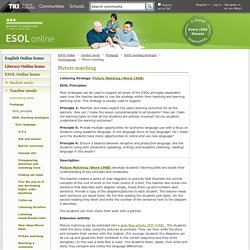

Tons of Language Activities for Specific Language Needs. Picture matching / Oral language / ESOL teaching strategies / Pedagogy / Teacher needs / ESOL Online / English - ESOL - Literacy Online website - English - ESOL - Literacy Online. Description: Picture Matching (Word 19KB) develops students’ listening skills and builds their understanding of key concepts and vocabulary.

The teacher creates a series of clear diagrams or pictures that illustrate the central concepts of the unit of work or the main events in a text. The teacher also writes one sentence that describes each diagram simply, mixes them up and numbers each sentence. Provide a copy of the diagrams/pictures to each student. The teacher reads each sentence out aloud twice. The students can then check their work with a partner. Extension activity: Picture matching can be extended into a skills flow activity (RTF 47KB) . Related activities:
Disappearing definition and vanishing cloze / Oral language / ESOL teaching strategies / Pedagogy / Teacher needs / ESOL Online / English - ESOL - Literacy Online website - English - ESOL - Literacy Online. Grammar and vocabulary: teaching students collocations. By Rachel Hunt A discussion and explanation of collocations and practical suggestions for teaching them.

How can I help my students with collocations? Advanced students need to be aware of the importance of collocation. I would argue that students at every level need to be aware of the importance of collocation, as I believe collocation can be used not only to help learners understand and manage lexis but also to communicate ideas more effectively. For example, one of my learners recently asked the difference in meaning between glance and glimpse. It was immediately clear to me how helpful it was to use collocation to highlight the differences between the two verbs. Light green / dark green but light suitcase / heavy suitcase. What is collocation? Latest gossip adjective + noun package holiday noun + noun have a great time verb + adjective + noun discuss calmly verb + adverb completely satisfied adverb + adjective hand in an assignment verb + preposition + noun. Caption Writing. Filed under ADVISERS, HANDOUTS, HELP!

, LEARNING CENTER, LESSONS, LIBRARY, PHOTOGRAPHY, PHOTOJOURNALISM, TEACHERS & ADVISERS, Uncategorized, WRITING Readers look at a photograph first, then the caption under the photo. If the caption intrigues them by providing context and background information, readers will look back at the photograph and see something new. It's called the loop, and their next stop is the story. A supercell thunderstorm rolls across the Montana prairie at sunset. Notice what you just did? The photo and caption complement each other. Every single photo must have a caption (newspaper people like to call them cutlines), and each must quickly tell the reader what the picture itself cannot say: Names, stories, dates, places, significance.
When it comes to copywriting, captions are the one-two punch that delivers. Captions that tell and intrigue National Geographic captions are excellent examples. Finish the picture story with words Strip the story Intrigue the reader Activities. 8 simple, yet powerful types of headlines. The first thing most readers notice in print or online is a headline.

Think of it as a virtual handshake. If your headline is the text equivalent of a cold, dead fish, you’ll make a poor first impression. Or think of it as analogous to a cover letter or a request for a date. You only get one chance to introduce yourself—make it good. Various types of headlines exist, and some are more suitable than others for various types of content. 1. Such an approach may seem dull, but consider that no single reader personality prevails; some people like an unadorned statement. Structured poems. Barrier Games: Great for Language Enrichment. Sentence Starters on Pinterest. Introduction to Sentence Combining - Sentence Combining Exercises. This exercise will introduce you to sentence combining--that is, organizing sets of short, choppy sentences into longer, more effective ones.

However, the goal of sentence combining is not to produce longer sentences but rather to develop more effective sentences--and to help you become a more versatile writer. Sentence combining calls on you to experiment with different methods of putting words together. Because there are countless ways to build sentences, your goal is not to find the one "correct" combination but to consider different arrangements before you decide which one is the most effective. An Example of Sentence Combining Let's consider an example. She was our Latin teacher. Have you succeeded in combining the sentences? Our Latin teacher in high school was a tiny woman.
If you're curious, here is the sentence that served as the original model for this little combining exercise: Patterned, Predictable Texts. Dictogloss. Listening is important.

Collaboration is important. Writing is important. Dictoglosses combine all of these these things to keep students' brains working in a foreign language. What is a dictogloss? I am glad you asked :) Dictoglosses are essentially dictation exercises where students work together to recreate a text. The teacher reads a text. SONGS Well, part of it means that you have to pick fun texts! DRAW AND TELL With lower students tell a draw and tell WITH the picture, and keept the picture up!
MOVIES/TELEVSION Again, keep the level of the student in mind. Drills, Dialogue and Role Play. Anchor Charts~Grammar on Pinterest. Sentence Frames.